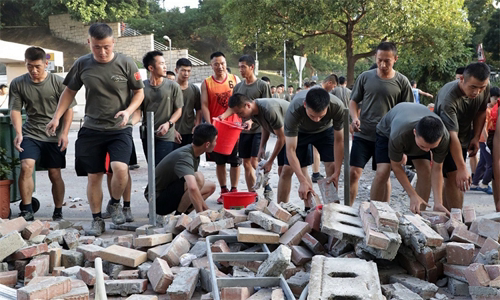Chinese soldiers are deployed to clear obstacles on the streets of Hong Kong today, after days of violent protests.
Dozens of soldiers, mostly in green T-shirts and black shorts, carrying red buckets came out of the camp in Kowloon Road around 4pm to clear obstacles on Renfrew Road, near the mold. Protestant University of Hong Kong. Firefighters and special police then came to help mainland Chinese soldiers.

Chinese soldiers clear obstacles in the streets of Hong Kong Photo: SCMP
This is the first time in more than a year that mainland Chinese troops stationed in Hong Kong have been mobilized to help the local community. More than 400 soldiers have been deployed to the main park in Hong Kong to clear fallen trees after the Mangkhut storm in October 2018.
One soldier said that the removal of stone bricks on their streets was not related to the Hong Kong Special Administrative Region government. "We started it ourselves. Preventing violence and ending chaos is our responsibility," the soldier said.
Before the Chinese soldiers appeared, about 20 people were carrying trolleys to clear bricks and other obstacles on the road.
Hong Kong security secretary John Lee Ka-chiu later said that the Chinese military stationed in the special zone had the right to decide for soldiers to voluntarily participate in support activities outside the area. quarter. John Lee Ka-chiu said the district government did not record how many of these activities occurred.
Under Hong Kong's Basic Residence and Basic Law, Chinese troops must not interfere in special zone matters. However, the Hong Kong Special Zone Government may require garrison forces to assist in disaster relief or maintain public order. No such request has been made since Hong Kong was handed over to China 22 years ago.
Chinese forces stationed in Hong Kong also need to notify the special zone authorities when they plan to carry out any military operations, such as training that could affect the lives of their citizens.
Many people in Hong Kong today are also involved in cleaning streets in some other areas. Hundreds of locals and alumni of Hong Kong University came to clear the obstacles erected by protesters on Pok Fu Lam Street on November 12. Some volunteers carried gloves, masks and crowbar to break the brick walls erected by protesters.
The obstacle clearing operation was peaceful, except for an argument outside the University of Hong Kong and a petrol bomb thrown from a bridge on Pok Fu Lam road. Volunteers have a stressful time with groups of protesters sitting in rows on the street.
The Pok Fu Lam road was reopened after many days of blockade at 16:00, the volunteers clapping as ambulances and cars passed through the area. However, the road section surrounding Hong Kong Polytechnic University and the port-connecting tunnel linking Hong Kong island with the Mekong region still faces many obstacles.
Demonstrators for days blockade Hong Kong's subway lines and routes, including violent acts such as throwing bricks, petrol bombs and burning fires, forcing riot police to use tear gas. , rubber bullets in response.
The Hong Kong police warned the violence was so dangerous it could even lead to death, after 64 people were injured and two in critical condition after the November 13 clash. Chief Special Officer Carrie Lam called protesters paralyzing Hong Kong "selfishers" and "enemies of the people".
Demonstrations in Hong Kong erupted in early June to protest the extradition bill that allows criminals to be sent to jurisdictions where the Special Zone has not signed an extradition treaty, including mainland China. The special zone government withdrew the bill, but protesters still took to the streets with other claims, including the police's request to investigate the use of force and Ms. Lam to resign.



 RashmiTripathy
RashmiTripathy







